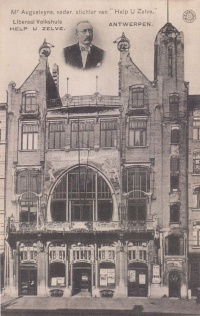Art Nouveau
From The Art and Popular Culture Encyclopedia
| Revision as of 22:20, 25 December 2022 Jahsonic (Talk | contribs) ← Previous diff |
Revision as of 22:21, 25 December 2022 Jahsonic (Talk | contribs) Next diff → |
||
| Line 1: | Line 1: | ||
| + | [[Image:Liberaal Volkhuis Help u Zelve in de Volksstraat.jpg |thumb|right|200px|[[Liberaal Volkshuis "Help U Zelve"]] (1901) in the [[Volkstraat]], see [[Art Nouveau in Antwerp]]]] | ||
| {| class="toccolours" style="float: left; margin-left: 1em; margin-right: 2em; font-size: 85%; background:#c6dbf7; color:black; width:30em; max-width: 40%;" cellspacing="5" | {| class="toccolours" style="float: left; margin-left: 1em; margin-right: 2em; font-size: 85%; background:#c6dbf7; color:black; width:30em; max-width: 40%;" cellspacing="5" | ||
| | style="text-align: left;" | | | style="text-align: left;" | | ||
| Line 5: | Line 6: | ||
| |} | |} | ||
| {{Template}} | {{Template}} | ||
| - | [[Image:Liberaal Volkhuis Help u Zelve in de Volksstraat.jpg |thumb|right|200px|[[Liberaal Volkshuis "Help U Zelve"]] (1901) in the [[Volkstraat]], see [[Art Nouveau in Antwerp]]]] | ||
| {{Template}} | {{Template}} | ||
Revision as of 22:21, 25 December 2022
|
"The erotic nature of many Art Nouveau works is one of the most prevalent features of the style. Nowhere is it more abundantly seen than in small-scale sculptural or decorative arts objects such as ink-wells, carafes, centrepieces, candelabra, lamps and figurines -- the kind of objects that were disseminated widely and could be brought into any middle-class household. The eroticism of these objects is made all the more complex by their utility and domesticity. They often demand physical engagement: furniture or carafes where the handles are naked women that must be grasped; vessels that metamorphosize into women inviting touch; lamps that provocatively pose women in suggestive positions. These erotically charged objects, unlike most sculpture, demand contact." --Ghislaine Wood, source pre-2004, probably via Art Nouveau and the Erotic (2000) |
|
Related e |
|
Featured: |
|
Related e |
|
Featured: |
Art Nouveau, (French for 'new art') is an international style of art, architecture and design that peaked in popularity at the beginning of the 20th century (1880s - 1910s) and is characterized by highly-stylized, flowing, curvilinear designs often incorporating natural forms such as floral and other plant-inspired motifs. More localized terms for the phenomenon of self-consciously radical, somewhat mannered reformist chic that formed a prelude to 20th-century modernism include Jugendstil in Germany and many other countries or skønvirke in Denmark, named after the avant-garde periodical Jugend ('Youth'), Młoda Polska ('Young Poland' style) in Poland, and Sezessionsstil ('Secessionism') in Vienna, where forward-looking artists and designers seceded from the mainstream salon exhibitions to exhibit on their own work in more congenial surroundings. Further centers were in Belgium (especially Brussels) and Scotland (Glasgow).
In Russia, the movement revolved around the art magazine Mir iskusstva ('World of Art'), which spawned the revolutionary Ballets Russes. In Italy, Stile Liberty was named for the London shop, Liberty & Co, which distributed modern design emanating from the Arts and Crafts movement, a sign both of the Art Nouveau's commercial aspect and the 'imported' character that it always retained in Italy.
In Spain, the movement was centred in Barcelona and was known as modernisme, with the architect Antoni Gaudí as the most noteworthy practitioner. Art Nouveau was also a force in Eastern Europe, with the influence of Alfons Mucha in Prague and Moravia (part of the modern Czech Republic) and Latvian Romanticism (Riga, the capital of Latvia, is home to over 800 Art Nouveau buildings).
The entrances to the Paris Métro designed by Hector Guimard in 1899 and 1900 are famous examples of Art Nouveau.
Contents |
Noted Art Nouveau practitioners
Architects
- Émile André (1871―1933)
- Gavriil Baranovsky (1860―1920)
- Peter Behrens (1868―1940)
- Georges Biet (1868―1955)
- Paul Charbonnier (1865―1953)
- Gino Coppedè (1866―1927)
- Raimondo Tommaso D'Aronco (1857―1932)
- Mikhail Eisenstein (1867 - 1921)
- August Endel (1871―1925)
- Max Fabiani (1865―1962)
- Antoni Gaudi (1852-1926)
- Vladislav Gorodetsky (1863-1930))
- Hector Guimard (1867-1942)
- Gustaw Landau Gutenteger (1862-1924)
- Paul Hankar (1859-1901)
- Josef Hoffmann (1870-1956)
- Victor Horta (1861-1947)
- Dawid Lande (1868-1928)
- Ödön Lechner (1845-1914)
- Lev Kekushev (1862-1919)
- Charles Rennie Mackintosh (1868-1928)
- Rafael Masó (1880-1935)
- Marian Peretiatkovich (1872-1916)
- Jože Plečnik (1872-1957)
- Fyodor Schechtel (1859-1926)
- Gustave Strauven (1878-1919)
- Louis Sullivan (1856-1924)
- László Székely (1877-1934)
- Eugène Vallin (1856-1922)
- Henry Van de Velde (1863-1957)
- Otto Wagner (1841-1918)
- William Walcot (1874-1943)
- Lucien Weissenburger (1860-1929)
Art, drawing, and graphics
- Aubrey Beardsley (1872-1898)
- Ivan Yakovlevich Bilibin (1876-1942)
- Walter Crane (1845-1915)
- Jules Cheret (1836-1932)
- Gaston Gerard (1878-1969)
- Gustav Klimt (1862-1918)
- E. M. Lilien (1874-1925)
- Jozef Mehoffer (1869-1946)
- Alfons Mucha (1860-1939)
- Ze'ev Raban (1890-1970)
- Valentin Serov (1865-1911)
- Konstantin Somov (1869-1939)
- Henri de Toulouse-Lautrec (1864-1901)
- Janos Vaszary (1867-1939)
- Mikhail Vrubel (1856-1910)
- Stanisław Wyspiański (1869-1907)
Mural and Mosaic designers
- Antoni Gaudi (1852-1926)
- Gustav Klimt (1862-1918)
- Alfons Mucha (1860-1939)
- Mikhail Vrubel (1856-1910)
Furniture designers
- Carlo Bugatti (1856-1940)
- Eugène Gaillard (1862-1933)
- Antoni Gaudi (1852-1926)
- Charles Rennie Mackintosh (1868-1928)
- Louis Majorelle (1859-1926)
- Jože Plečnik (1872-1957)
- Henry van de Velde (1863-1957)
Glassware and Stained Glass designers
- Auguste Daum (1853-1909)
- Antonin Daum (1864-1930)
- Émile Gallé (1846-1904)
- Jacques Gruber (1870-1936)
- René Lalique (1860-1945)
- Charles Rennie Mackintosh (1868-1928)
- Louis Comfort Tiffany (1848-1933)
- Stanisław Wyspiański (1869-1907)
- Sanchi Ogawa (1867-1928)
Other decorative artists
- Charles Robert Ashbee (1863-1942)
- Will H. Bradley (1868-1962)
- Jules Brunfaut (1852-1942)
- Jan Bukowski (1873-1938)
- Auguste Delaherche (1857-1940)
- Georges de Feure (1868-1928)
- Archibald Knox (1864-1933)
- Hermann Obrist (1863-1927)
- Jane Spensor (1845-1922)
- Artus Van Briggle (1869-1904)
- Philippe Wolfers (1858-1929)
See also


